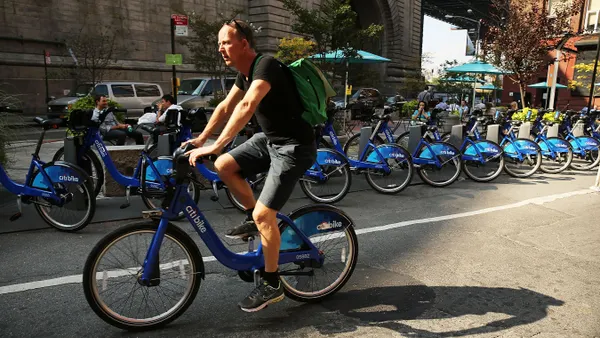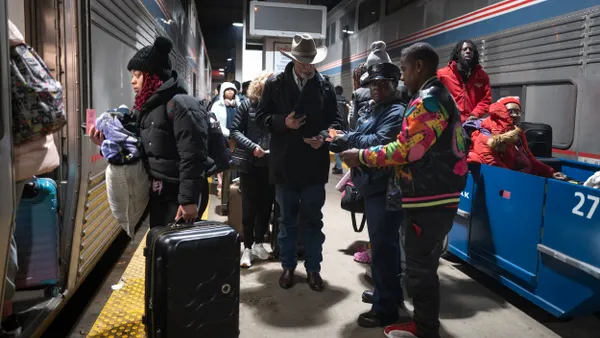Last month, a carefully-selected group of six technology startups completed the first Transit Tech Lab program, an eight-week accelerator to develop tech-driven solutions to two of New York City's most pressing transportation issues: bus efficacy and subway delays.
For Rachel Haot, executive director of the Transportation Innovation Partnership which oversees the Lab, the accelerator experience was "overwhelmingly positive." Under Haot's leadership, the Lab sorted through nearly 100 startup applications with an eye on impact, product, value and team, to eventually narrow down to six companies with the most promising solutions for transit woes: Axon Vibe, Palisade Labs, PIPS Technology, Preteckt, Remix and Veovo.
Each of the companies was challenged to develop a proof of concept during the accelerator program, with the ultimate goal of being selected to deploy a 12-month, unpaid pilot with the Metropolitan Transportation Authority (MTA). In June, the Lab will announce the winners.
In anticipation of that announcement, Smart Cities Dive caught up with Haot at the Smart Cities New York conference to gain insights into the accelerator and peel back the layers of transportation development in New York.
This interview has been edited for clarity and brevity.
SMART CITIES DIVE: What was your motivation behind launching the Tech Lab?
HAOT: Our immediate motivation was that New York City has a transit system in crisis. We also knew that New York has incredible resources, a very strong technology sector, the biggest, most sophisticated companies in the world … How do we identify and evaluate technology solutions that can help to solve this transit crisis? How do we create a repeatable system that allows the MTA to learn about new technologies that can help them solve these problems, that does so on an accelerated timeline, where there’s a clear outcome and a structured pathway?
The key thing here was that we kept it open enough so that we could welcome new approaches to these longstanding challenges, but it was narrow enough that everything was workable within the MTA ... There were operators and champions who were ready to take these technologies and run with them. And they did a phenomenal job.
Without this Transit Tech Lab, how was the MTA looking at innovation before? What gap were you bridging?
HAOT: Essentially, the alternative to this is the traditional request for proposals (RFP) and procurement system. Typically the way that any government entity procures technology is that they write extremely detailed, very limited, very restrictive RFPs based on exactly what they need or exactly what they think they need, and that’s because that’s the way it’s always been done and those are the rules. The challenge there is ... the government is repeatedly procuring the same product, maybe making slight tweaks because it’s in the mold of what’s happened before and it’s the path of least resistance. They don’t know what they don’t know.
One challenge is, it’s very restrictive. You’re not able to welcome new and emerging technologies that have emerged in the past couple of years. The other challenge is there are very onerous requirements that are traditional and maybe not geared toward startups or emerging technology companies, so they can’t even apply. The third challenge is that more culturally, startups and emerging tech companies may think they are not a fit for doing business with government or they may think it’s too daunting, or they simply aren't in the loop for these opportunities so they don’t even see that these things happen.
The MTA will put out RFPs and get no responses and they’ll think the technology doesn’t exist. But what we’ve proved to them is, it does exist, you do have to work harder to get the word out, you do have to do some research and identify who in the space can respond to this, and then you have to build the trust in the organization that you are willing to try something new and that you are a good partner.
Are there other cities that have this type of Transit Tech Lab, or could you expand this?
HAOT: After we announced [the Lab], we heard from a number of different cities and different transit agencies who were interested in deploying the same model. The interest is absolutely there. About a week after we introduced our Transit Tech Lab, London announced a similar program ... We’ll talk with other people in similar roles in different cities, and they’re interested in hearing about the success stories from our Transit Tech Lab because the same issues happen in most major metropolitan cities.
In our next phase, what we’re doing is we are starting to look regionally at other transit agencies to see if they have common challenges, so that the can be a part of the next round of Transit Tech Lab challenges to deploy pilots that are more interoperable, more seamless and more effective, because there are a lot of overlap in jurisdictions in New York.
You’re a born-and-raised New Yorker and you’ve watched the evolution of public transit in this city. What frustrations did you have in the past that you’ve seen improved?
HAOT: Some of my earliest memories were of taking the subway and how much I loved it ... I can still picture it in Brooklyn, where I was a little girl riding the subway. It’s funny because even today, I see that with my own kids. They’re obsessed with taking the bus, it’s their favorite thing to do. There is this appreciation on some levels that it is a real part of the fabric of the city and it is critical to the future of the city.
The interest came less out of a sense of frustration and more out of a sense of opportunity. When I was at the City of New York as the Chief Digital Officer, we had a very data-driven approach to how we engaged with New Yorkers and the topics that were most important to them. Transportation was always top of the list. It was always the most critical thing, especially in times of emergency ... It became very clear to me that if there’s an area you want to hone in on in a city that touches everyone, because everyone has to move around, it’s transportation.
"There is this appreciation on some levels that [public transit] is a real part of the fabric of the city and it is critical to the future of the city."

Rachel Haot
Executive Director, Transportation Innovation Partnership
And when you look at transportation you realize it’s not just about movement — it’s really about housing, it’s about workforce, it’s about schools because that’s how you get between these different places ... To me, it’s really an incredible lens to looking at how we can improve cities and that’s why I was so interested in the opportunity, and that coupled with the explosion of investment in the mobility sector that we’re seeing from the private sector. The central question is how can we help these two worlds come together for the greater good and how can they apply these technologies that are transforming the world to an area of the city that really needs it.
How do established private sector companies like Uber and Lyft play into your work?
HAOT: Broadly speaking, we want to support the best-in-class companies creating the most interesting, compelling technology that has potential to help them become a bigger part of the fabric of public transit. We want the best players to be working with the most sophisticated companies. I think there’s a role for everyone.
Apps like Uber and Lyft ... when they, for example integrate transit location information and wayfinding, I see that as supportive to the system. If we can move toward greater interoperability around ticketing, I also see that as supportive. I think public transit can learn from ride-hailing companies around customer service and the phenomenally customer-centric experience of opening an app and having that ride. How can we bring that to public transit?
Do you have any involvement in making sure infrastructure is in place to get people to public transit?
HAOT: In a city as complex as New York with many different competing interests, it is challenging to implement permanent infrastructure, but when we look at the data, we do know protected bike lanes, dedicated and protected bus lanes, are the types of infrastructure investments — at least when we’re talking about the streetscape — that are critical to making new first and last mile micromobility options feasible in an urban environment.
We’re approaching this from a digital perspective. One of the companies we’ve worked with through the Transit Tech Lab is called Palisade Labs. They used camera feeds from video cameras mounted on buses — thousands and thousands of hours of camera feeds — and they coupled that with computer vision algorithms that they developed to identify what’s actually happening in our streetscapes and what’s slowing down buses. They matched data from the bus telematics system, every time they were slowing down, with what was happening in the video feed to identify a real data-driven approach of, 'Here’s what’s happening on our streets.' … What the MTA did is they used that data and shared it with the DOT to say this is where we really need improvements and that helps to make the discussion a lot more objective when you have the data right there.
Is there a city that you admire or hope to mirror through your work?
HAOT: Right now as we look to implement congestion pricing, we’re looking at models from London, Singapore and Stockholm. If I was going to look purely at a public transit systems, I think Hong Kong, Tokyo and Singapore are up there as the Holy Grail; they have nearly 100% on-time performance rates in sort of comparable areas, and Hong Kong specifically is profitable. Through development and this public-private model that they have, they’ve been able to make their system profitable and sustainable. That would be transformative for New York.










